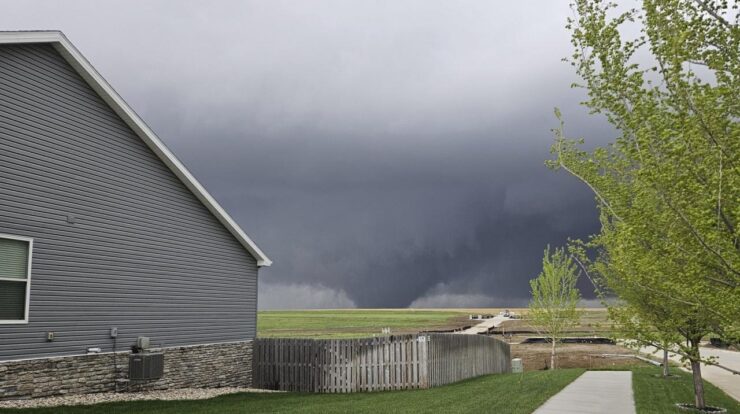
Nebraska Tornado News: Unraveling the complexities of tornadoes in the heartland of America. From their historical occurrences to the scientific factors behind their formation, this comprehensive report delves into every aspect of Nebraska’s tornado activity, providing valuable insights and essential safety guidelines.
Nebraska, a state situated in the Great Plains, has a long history of tornadoes, with some of the most notable events leaving a lasting impact on communities. This report explores the geographical and meteorological factors that contribute to tornado formation in the state, shedding light on the processes involved in their development.
Nebraska Tornado History
Nebraska has a long and well-documented history of tornadoes, with an average of 52 tornadoes occurring in the state each year. The state’s most destructive tornado was the Hallam tornado of 1980, which killed 10 people and injured 67.
Other notable tornadoes in Nebraska include the Omaha tornado of 1975, which killed three people and injured 133; the Grand Island tornado of 1982, which killed five people and injured 100; and the Pilger tornado of 2014, which killed one person and injured 19.
Notable Tornadoes in Nebraska
| Date | Location | Fatalities | Injuries |
|---|---|---|---|
| May 6, 1975 | Omaha | 3 | 133 |
| June 3, 1980 | Hallam | 10 | 67 |
| June 2, 1982 | Grand Island | 5 | 100 |
| June 16, 2014 | Pilger | 1 | 19 |
Causes of Nebraska Tornadoes
Nebraska is located in the Great Plains, which is a region of the United States that is particularly prone to tornadoes. The Great Plains is a flat, open area with few trees or other obstacles to block the wind. This allows the wind to blow freely and create the conditions that are necessary for tornadoes to form.
The jet stream is a high-altitude wind current that flows from west to east across the United States. The jet stream can help to create tornadoes by providing the wind shear that is necessary for tornadoes to form.
Process of Tornado Development
- Updrafts:Warm, moist air rises from the ground, creating an updraft.
- Rotation:The updraft begins to rotate as it interacts with the wind shear from the jet stream.
- Condensation:As the air rises, it cools and condenses, forming a cloud.
- Funnel Cloud:The rotating cloud extends downward and forms a funnel cloud.
- Tornado:When the funnel cloud touches the ground, it becomes a tornado.
Tornado Safety and Preparedness

If you are in Nebraska during a tornado warning, you should take the following steps:
- Seek shelter immediately.The best place to shelter from a tornado is in a basement or underground storm shelter.
- If you are in a building, go to the lowest level and find a windowless room.If you are in a mobile home, leave it and seek shelter in a sturdy building.
- Stay away from windows.If a tornado breaks a window, the glass can shatter and cause serious injuries.
- Cover your body with blankets or pillows.This will help to protect you from flying debris.
Tornado Emergency Kit, Nebraska tornado news
- First aid kit
- Water
- Food
- Flashlight
- Battery-powered radio
- Whistle
Nebraska Tornado Research and Forecasting
The National Weather Service (NWS) is responsible for forecasting and warning of tornadoes in Nebraska. The NWS has a network of weather stations and radar systems that are used to track tornadoes and issue warnings.
The NWS also conducts research on tornadoes in Nebraska. This research helps to improve the NWS’s ability to forecast and warn of tornadoes.
Advancements in Tornado Detection and Prediction
- Doppler radar:Doppler radar can detect the rotation of tornadoes, which helps to improve the NWS’s ability to issue warnings.
- Spotter networks:Spotter networks are groups of volunteers who report tornadoes to the NWS. This information helps the NWS to track tornadoes and issue warnings.
- Numerical weather prediction models:Numerical weather prediction models are computer models that can simulate the atmosphere and predict the weather. These models are used to help the NWS forecast tornadoes.
Impact of Nebraska Tornadoes
Tornadoes can have a devastating impact on Nebraska communities. Tornadoes can destroy homes and businesses, and they can also cause injuries and death.
The economic impact of tornadoes can be significant. Tornadoes can damage or destroy crops, and they can also disrupt businesses and transportation.
Case Study: Pilger Tornado of 2014
The Pilger tornado of 2014 was an EF4 tornado that caused extensive damage to the town of Pilger, Nebraska. The tornado killed one person and injured 19 others. The tornado also destroyed or damaged 80% of the buildings in Pilger.
Nebraska Tornado Climatology
Tornadoes can occur in Nebraska at any time of year, but they are most common in the spring and summer months. The peak tornado season in Nebraska is from May to June.
Tornadoes are most common in the eastern part of Nebraska, but they can occur anywhere in the state.
Distribution of Tornadoes in Nebraska
The map below shows the distribution of tornadoes in Nebraska. The map shows that tornadoes are most common in the eastern part of the state.
[Map of Nebraska showing the distribution of tornadoes]
Outcome Summary: Nebraska Tornado News
Understanding Nebraska’s tornado climatology, including seasonal patterns and geographical variations, is crucial for effective preparedness and mitigation efforts. The report analyzes the distribution of tornadoes across the state, highlighting the areas most vulnerable to these powerful storms.
In conclusion, Nebraska Tornado News serves as a valuable resource for anyone seeking to gain a comprehensive understanding of tornadoes in Nebraska. Its detailed analysis, practical safety guidelines, and insights into the latest research and forecasting advancements empower readers with the knowledge they need to stay informed and prepared.
FAQ Summary
What is the average number of tornadoes in Nebraska each year?
Nebraska experiences an average of 50 tornadoes annually, ranking among the top tornado-prone states in the United States.
What is the most destructive tornado in Nebraska history?
The Hallam tornado of 1980 remains the most destructive tornado in Nebraska’s history, causing extensive damage and claiming the lives of 10 people.
What are the warning signs of a tornado?
Approaching dark, rotating clouds, a funnel-shaped cloud extending from the base of a thunderstorm, and a loud, roaring sound are all signs of an impending tornado.
What should I do if I am caught in a tornado?
Seek immediate shelter in a sturdy building, basement, or underground structure. Stay away from windows and exterior walls.





